Abstract
This research examines the significance of restoring efficient water management systems in India’s semiarid environment, with special emphasis on the role of traditional irrigation structures, such as tanks, in collecting and storing limited water resources. Assessing the benefits of any restoration program, especially when socioeconomic and environmental benefits are involved, is challenging. In the context of tank rehabilitation, a cost-benefit analysis will be conducted regarding economic and ecological returns in the post-desiltation phase. Since the restoration process requires a significant investment, assessing the project’s viability during the planning stage is better. The present study proposes a novel method to indirectly analyse the cost-benefit of the tank restoration process by correlating run-off and storage capacity of tanks before the planning phase. The Ambuliyar sub-basin, which covers an area of 930 square kilometres in Tamil Nadu, India, comprising 181 tanks (water bodies) of varying sizes and shapes, was taken for this study. This study employed the Soil Conservation Service Curve Number (SCS-CN) method, incorporating factors such as soil type, land cover, land use practices, and advanced remote sensing and Geographic Information System (GIS) tools to simulate surface run-off. Run-off volume and tank capacity were compared for all seasons at the micro-watershed level. The results demonstrated that the run-off volume in each micro-watershed significantly exceeded the tank capacity across all seasons. Even during the summer, the run-off volumes in the micro-watershed were considerably higher than the tank capacity. The findings suggest tank restoration can effectively store run-off and significantly fulfil agricultural and other essential needs throughout the year, thereby improving the local rural economy. This study also highlights the need for periodic maintenance and rehabilitation of these tank systems to retain their functionality.
1. Introduction
India’s semiarid environment and fluctuations in precipitation over time and space result in limited water sources [1]. Therefore, it is crucial to implement efficient water management systems for collecting and storing monsoonal run-off. Traditional irrigation structures, like tanks, have been strategically built across the subcontinent to harness and preserve scarce water resources [2,3]. These ancient reservoirs not only capture rainwater but also serve as vital lifelines for agriculture, sustaining communities and ecosystems in arid systems [4,5]. A well-maintained tank system can store water for more than one year. In addition to storage, these tank systems serve multiple functions such as flood control, groundwater recharge, and off-site soil conservation. It is essential to periodically desilt and rehabilitate these tank systems to retain their functionality [6,7]. Recognising the importance of tanks, the kings’ patronage, and support for community-based maintenance and management of water bodies such as tanks, canals, and other irrigation infrastructure, namely “Kudimaramathu” [8,9]. British rule centralised control over water resources, which led to a lack of community involvement, resulting in negligence and deterioration of irrigation infrastructure. Desilting a tank with a surface water spread area of 1.0 sq. km costs approximately USD 2.002 million [10]. There are around 39,000 tanks in Tamil Nadu alone, whereas the total number of tanks in India is more than 0.2 million [11]. In rehabilitation projects, a cost-benefit analysis comparing the anticipated benefits with the costs of implementation must be performed to assess the effectiveness of the project. This is essential for decision makers to determine whether a project is economically viable. Benefits were evaluated based on their direct and indirect impacts. In general, the benefits of tank rehabilitation projects are often assessed indirectly using measures such as increased water availability, reduced soil erosion, improved ecosystem services, increased crop production, and improved living standards [12]. Unfortunately, these metrics will be evaluated several years after the completion of the project, which means in the post-project phase. This study offers a novel and systematic framework for assessing the economic feasibility of a tank rehabilitation project even during the pre-desiltation phase. Although the benefit-cost ratio of such large-scale socio-environmental projects cannot be evaluated immediately, it can be determined by correlating the surface run-off and tank capacity after restoration [13].
Conventional methods for estimating run-off often suffer from errors and require extensive data processing. Researchers worldwide have used several methods to estimate run-off accurately [14,15]. Empirical equation methods, such as the Rational Method and SCS, are widely used. The CN method estimates run-off based on the correlation between historical data and other variables, such as rainfall, soil type, and land use. However, the availability of historical data limits the applicability of these models. Alternatively, hydrologic models such as SWAT and HEC-HMS simulate water flow through a hydrological cycle. However, these methods require large amounts of data and computational resources. Remote sensing techniques estimate surface run-off using satellite imagery by analysing land cover, soil moisture, and other parameters. Nevertheless, their usefulness is limited by their temporal resolution, cloud cover, and sensor capabilities. Rainfall-runoff models use physical equations to simulate rainfall-runoff but may pose challenges in calibrating and validating these results. The method choice depends on this study’s scale, data availability, computational resources, and the precision required.
The SCS-CN method has advantages over other methods because it incorporates factors such as land cover, soil type, land use practices, surface conditions, and antecedent moisture conditions, along with advanced tools such as remote sensing and GIS. The method was initially designed for small watersheds and later extended to larger watersheds by integrating Weighted Curve Numbers (WCN) [16]. In addition to run-off estimation, this method has various applications [17]. For instance, Pachpute (2009) evaluated the sustainability of different rainwater harvesting systems in rural Tanzania’s Makanya catchment, considering factors such as rainfall variability, run-off quality, and quantity [18]. Additionally, Gajbhiye (2014) employed this method for the effective prediction of sediment yield estimation in the Narmada watersheds [14]. Khaleghi (2017) utilised this technique to develop a geomorphological instantaneous unit hydrograph, assessing increased run-off generation potential in the Talar watershed resulting from deforestation over the past four decades [19], Tripati (2021) utilised the SCS-CN method for estimating run-off and rainfall in Rupnagar during the destructive floods in 2019 [20].
Unpredicted weather patterns like droughts and water scarcity are common problems in semiarid and arid regions like India. Hence, restoring traditional water management systems, mainly minor irrigation tanks, is of paramount importance. Our study evaluated the benefits of tank rehabilitation projects, emphasising their role in collecting and storing limited water resources. We propose a novel approach to assess rehabilitation benefits by correlating the surface run-off simulation using the SCS-CN model with the storage capacity of a minor irrigation tank. While the SCS-CN has been utilised for multiple purposes, there remains a significant research gap in calculating the run-off in the Ambuliyar sub-basin [21].
Furthermore, the Thiruvarankulam Block comprises a significant portion of the study area and has been classified as semi-critical by the Central Groundwater Board. Despite the existence of 850 irrigation tanks, the shortage of water resources is attributed to siltation and subsequent loss of storage capacity in these tanks [22,23]. Our study aimed to fill the research gap concerning run-off variability and its impact on tank storage capacity. We emphasise the importance of conducting a pre-desiltation analysis to evaluate the cost-effectiveness of tank restoration projects.
2. Materials and Methods
2.1. Study Area
The Ambuliyar Watershed (code No. 4A2B7), located in the Thanjavur and Pudukottai districts of Tamil Nadu, India, covers an area of 930 square kilometres (Figure 1). Weathered and fractured Granitic Gneiss dominates the western and southern parts of the study region. In contrast, clayey sandstone, silty clay, and sandstone dominate the north, with recent alluvium lining the coastal edges. The topography of the region slopes gently towards the east, with a gradient of 4°. The drainage network of the region includes the Ambuliyar River and its tributaries: Maruthangudiyar, Viluniar, and Punaikuthiar. Irrigation mainly depends on tanks, tube wells, and canals, with a tank system comprising approximately 850 tanks of varying sizes and configurations. However, these tanks have lost their functionality over time. Despite obtaining a yearly average of 910 mm of rainfall, the deteriorated tank system causes most stormwater to run-off into the Bay of Bengal as surface sheet flow. Considering the prevailing water crisis, the implementation of tank rehabilitation measures is imperative.
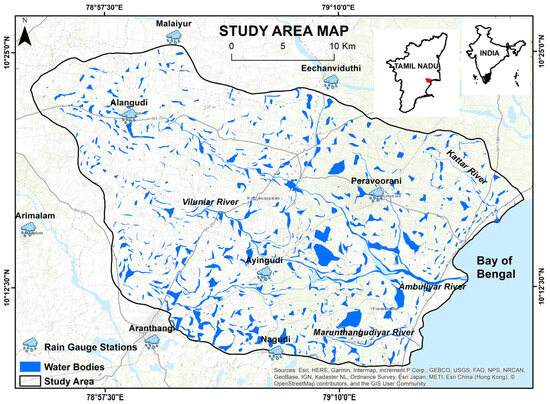
Figure 1.
Illustrates the location of the study area, tanks, and other water bodies.
2.2. Materials
This study used satellite images and GIS for data input and thematic map generation. A Digital Elevation Model (DEM) from the Shuttle Radar Topography Mission (SRTM) was used to define the micro-watersheds. This was accomplished using SRTM 1 arc-second satellite data at a spatial resolution of 30 m. Landsat OLI 8 satellite images (acquisition date: 2 January 2023) were analysed. The United States Geological Survey (USGS) provides satellite images. The Tamil Nadu Agriculture Department soil map was used to understand soil properties within the watershed better. Table 1 summarises the data used in this study. Hydrometeorological data, particularly rainfall data, are crucial for run-off estimations. The Indian Meteorological Department (IMD) collected rainfall data from 12 rain gauge sites in the research area between 1975 and 2021 (Table 2). Topographic sheets from the OSM series (58J15, 58J16, 58N3, 58N4, 58N7, and 58N8) covering the study area were acquired from the Survey of India (SOI). This comprehensive integration of data sources and technology helps to create a robust and informed method for investigating run-off dynamics at the micro-watershed scale.

Table 1.
Illustrates the details of the satellite images, their sources, and the resolution used in the present study.

Table 2.
Details the spatial locations of the rain gauge stations used in this study.
2.3. Methods
We used SRTM 1 arc-second satellite data to demarcate the study boundary and extract drainage networks. Initially, we filled depressions in the grid to create a topographically consistent DEM. The flow direction tool then assigns a value to each cell, implying the steepest descending direction. Flow accumulation calculations were then performed to delineate stream channels and micro-watersheds. The generated drainage network was validated using the drainages visible in the satellite images and SOI topographic sheets. The derived map showed approximately 163 micro-watersheds in the study area. The study area comprises 181 tanks (water bodies) of varying sizes and shapes. Their actual storage capacities were collected from archival records from the Public Works Department (PWD) archival records. The IMD collected daily rainfall data from 12 rain gauge stations in and around the research area over 41 years, from 1970 to 2021. Land Use and Land Cover (LULC) determine run-off factors, such as infiltration rates, soil erosion levels, and evapotranspiration. Landsat 8 OLI imagery was used for LULC classification using the ENVI 4.3 software. The image was pre-processed to enhance data quality, including radiometric, atmospheric, and geometric corrections. The soil map was transformed into Hydrological Soil Groups (HSG) based on factors such as infiltration rate, texture, depth, drainage conditions, and water transmission. The HSG values were assigned assuming the soil was barren and seamlessly integrated into the hydrological model. The annual and seasonal mean rainfall was estimated using the arithmetic mean approach. We identified the micro-watersheds influenced by each rainfall station using the Thiessen polygon method. The mean values obtained from this analysis were assigned to the appropriate micro-watersheds. The SCS-CN technique calculates run-off depth and volume by integrating factors such as land use and cover, HSGs, and Antecedent Moisture Conditions (AMC) [21,24,25,26,27]. The present study utilised all three antecedent soil moisture condition categories: AMC–I, AMC-II, and AMC-III [28]. LULC is considered in this integration, to delineate the different land types that contribute to run-off [29]. HSGs are critical factors, which are used to categorise soil types based on their infiltration rates and water-holding capacities, which directly impact run-off generation [30,31]. Additionally, AMC play a crucial role, representing the soil water content before a rainfall event and influencing how much water can infiltrate versus becoming surface run-off. We used GIS to integrate the HSG and LULC layers and then assigned CN to the intersecting LULC-HSG categories based on the corresponding AMC conditions.
The primary objective is to establish a correlation between seasonal run-off and tank storage capacity at the watershed level. Consequently, we used SOI topographic sheets to digitise water bodies with a water spread area larger than 0.1 square kilometres, and then we updated them using satellite pictures. Subsequently, data regarding the present and actual storage capacities of these tanks were retrieved from PWD archives. The run-off volume was determined for each season using the SCS-CN approach for each micro-watershed. These were then correlated with the predicted actual storage capacity of the tanks. Thus, the water retention ability of the tanks was examined. QGIS 3.16.16 and ERDAS Imagine 2015 were used to design, analyse, and generate different layers and maps. Figure 2 depicts the outline of the workflow and computations, the elaboration of which will be provided in the subsequent section.
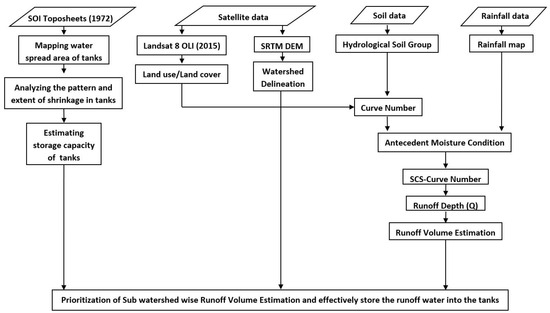
Figure 2.
Shows the methodological flowchart outlining the research process employed in the study.
2.4. S.C.S.–C.N. Model
One popular technique for calculating run-off and volume at the micro-watershed level is the SCS-CN. It integrates watershed characteristics and climate variables into a single entity known as CN. CN, a dimensionless parameter representing a watershed’s run-off potential, is determined by integrating factors such as LULC, HSGs, and AMC. The National Resources Conservation Service (NRSC) coined the term HSG and classified soils with similar physical and run-off properties into A, B, C, and D. Soils in Group A will have good infiltration rates but low run-off potential. In contrast, soils in Group B had moderate infiltration rates but moderate run-off potential. Group C was distinguished by soils with low infiltration rates and relatively high potential for run-off. In contrast, Group D comprised soils with extremely low infiltration rates and a high capacity for run-off.
The AMC describes the watershed’s pre-storm moisture content and soil storage capacity. The total rainfall values for the previous five days were collected from the IMD, and the AMC for each storm event were assessed. Documents indicate that the study area is subject to all three AMC levels: AMC I (wetting conditions), AMC II (normal conditions), and AMC III (conditions of considerable rainfall). Initially, the CNII for the AMC-II was derived. The obtained CNII values were then used to compute curve numbers I (CN I) and III (CN III). The LULC and HSG layers were spatially integrated, and Curve Number II (CN II) values were assigned to each LULC-HSG class based on their combination. Subsequently, CNII was converted into (CNI) and (CNIII) associated with (AMC-I) and (AMC-III) using Equations (1) and (2), respectively [32].
2.4.1. Weighted Curve Number
Different land and soil units may contribute to run-off in a micro-watershed. Therefore, a WCN method was employed to evaluate the overall run-off potential comprehensively. Initially, the weight of each land unit was calculated based on its area or run-off contribution. After determining the CN-II values for various land uses and their corresponding HSGs, WCN were calculated for each sub-watershed area (Equation (3)). This calculation involved multiplying each CN value by its associated area and dividing the result by the overall sub-watershed area, as indicated by the formula based on [33]:
where a1 is the area of that specific land unit 1, ∑ is the overall area, and CN is the curve number in that particular land unit 1. This weight signifies the relative importance of each land unit in the context of run-off generation within the watershed.
2.4.2. Calculation of Run-Off Depth (Q)
For each watershed, the potential maximum soil retention (S) (Equation (4)) was calculated using the formula provided by the Soil Conservation Service (SCS 1985) after the WCN based on the Antecedent Moisture Condition (AMC) was calculated:
where CN varied from 0 to 100.
Subsequently, the run-off estimation in the present study utilised Equation (5), which applies to all soil regions in India, except for black soil areas, as suggested by [33]:
- Q = direct flow volume represented in depth (mm)
- P = rainfall (mm)
- S = potential maximum soil retention
Notably, the retention parameter (S) exhibited spatial variability owing to changes in soil, land use, and slope. Additionally, it undergoes temporal variations owing to changes in the soil–water content over time.
3. Results and Discussion
3.1. Land Use and Land Cover
LULC mapping was conducted using Landsat 8 OLI satellite images. Ground-truth data for various LULC categories were collected in the field using a GARMIN handheld GPS device to establish training samples for each LULC class [34,35]. ENVI 4.3 software was used to perform Maximum Likelihood Classification. The study area encompasses nine distinct LULC categories: cropland, water bodies, built-up land, land with scrubs, land without scrubs, plantations, fallow land, wasteland, and wetlands (Figure 3). Then, classification accuracy was assessed using independent ground-truth data collected during fieldwork. Subsequently, by integrating it with the watershed layer (Figure 3), the area of the LULC categories within each watershed was calculated, and the results are presented in Table S1 in the Supplementary Materials.
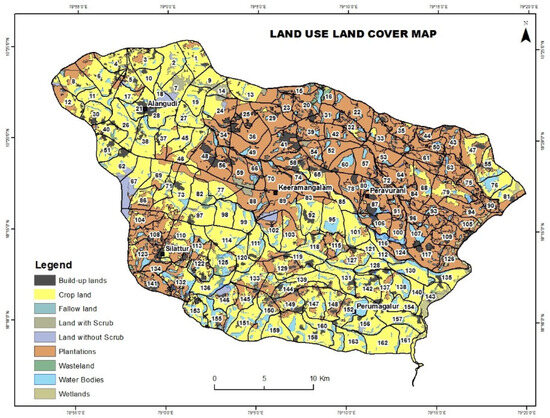
Figure 3.
Illustrates land use and land cover classification, including micro-watershed boundaries within the study area.
According to these data, significant plantations and croplands were found throughout the study area. Plantations are widely distributed throughout the northern region of the study area and coexist alongside croplands, built-up areas, and water bodies. In contrast, built-up areas, water features, agriculture, and plantations dominated the southern region. Additional LULC classes were dispersed throughout the study area. The analysis of the area occupied by different LULC classes showed that cropland dominated the LULC classes, occupying 473.56 sq. km, followed by plantations at 183.34 sq. km. In contrast, wasteland occupied the least area of 4.49 sq. km.
3.2. Hydrological Soil Group Map
The soil exhibited distinct patterns across different regions of the study area (Figure 4). The western part is predominantly characterised by laterite soil cover. In contrast, clay, shale, and argillaceous sandstone with shale comprised the central region of this study, extending from the north. Sandy and silty soils dominate coastal fringes. The southernmost portion of the research area comprised clayey sand, silt, and clay partings. In addition, shale and sandstone cover some of the western region.
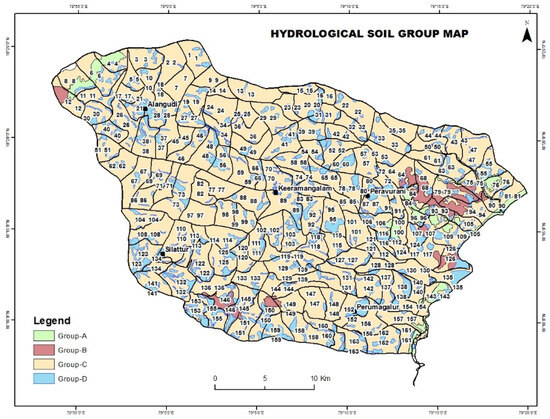
Figure 4.
Depicts hydrological soil groups along with micro-watersheds in the study area.
Water transmission capacity, drainage conditions, depth, texture, and infiltration rate are the factors that the United States Department of Agriculture (USDA) uses to classify soils (Table 3) (https://egov.usda.gov, accessed on 1 May 2024) [36]. As shown in Table 3, Group C had a low infiltration capacity and moderately high run-off [28]. Thus, clay, shale, argillaceous sandstone with shell lime, and laterite soils were categorised as HSG C. Similarly, the remaining soils in the study area were classified under appropriate HSG categories based on their characteristics, and Group C was widespread across the study area, especially in urban areas such as Alangudi and Peravurani. In contrast, HSG A and B were predominantly found in coastal regions. Groups A, B, and D were scattered throughout the study area. Subsequently, the areas under various HSG in each sub-watershed were calculated by integrating the watershed map (as illustrated in Figure 4 and detailed in Table S2 in the Supplementary Material). Group C comprises an area of 761.2 sq. km, followed by Group D (117.3 sq. km. Groups A and B, on the other hand, encompass 24.6 and 24.3 square kilometres, respectively.

Table 3.
HSG, according to the USDA-SCS classification.
3.3. Rainfall
The IMD provides daily rainfall data for 53 years (1970–2023). Rainfall data were collected from 12 rain gauge stations in and around the study area. Using the arithmetic mean method, we determined each rain gauge station’s monthly, seasonal, and annual mean rainfall [37]. Hydrologists frequently employ the Thiessen Polygon method, called the Voronoi diagram or proximity-based method, to define watersheds. The method divides the study area into regions according to the proximity of rain gauge stations, providing a practical approach to identifying micro-watersheds under the influence of a particular rain gauge station. Accordingly, the Thiessen polygon approach was used to identify micro-watersheds affected by rainfall stations, as shown in Table 4 [38]. The mean rainfall was then allocated to specific micro-watersheds based on their proximity to rain gauge stations (Figure 5).

Table 4.
Showing rain gauge stations and their influencing watersheds.
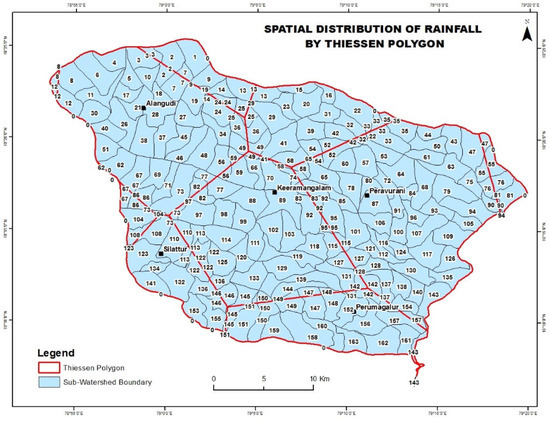
Figure 5.
Displays the spatial distribution of rain gauge stations and their influence on micro-watersheds within Thiessen polygons.
3.4. Derivation of Weighted Curve Number
As stated earlier, the LULC, HSG, and micro-watershed GIS layers are spatially integrated sequentially [39]. The CN-II values were then assigned and calculated for each micro-watershed, as shown in Table 5. The CN-II values range from 0 to 100, revealing watersheds’ infiltration and run-off characteristics. The lower values suggest higher infiltration and lower run-off rates, whereas higher values signify low infiltration and higher run-off. For instance, if a sub-watershed intersecting polygon comprised cropland as land use and Group A as the HSG, the assigned CN-II value would be 67, as illustrated in Table 5. LULC categories such as waterbodies, wetlands, and built-up areas fall under HSG Groups B, C, and D, signifying moderate to high run-off and moderate to low infiltration [27]. Accordingly, the CN values were 100, 95–98, and 89–95, respectively. This process of assigning CN-II values was iterated across all land use and soil group combinations within the 163 sub-watersheds. Overall, the LULC plantation with HSG A had a low CN-II value of 45, followed by a wasteland at 49. This reflects the ease of water infiltration into the ground in the vegetated areas. Subsequently, a WCN was computed for the entire watershed by amalgamating the curve number values with their corresponding weights (Table 5) (Figure 6, Figure 7 and Figure 8).

Table 5.
Weighted Curve Number II (CN-II) for various integrated land use, land cover, and hydrological soil group features.
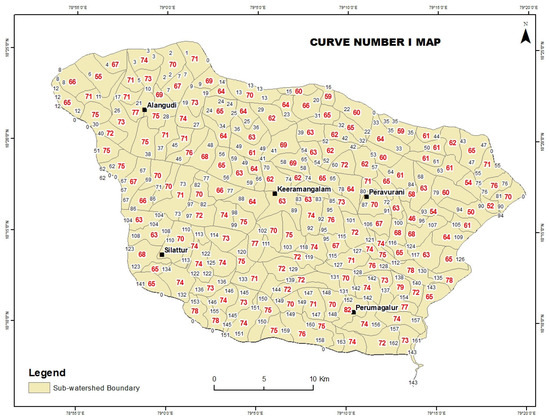
Figure 6.
Illustrates the assignment of Curve Number I to each micro-watershed.
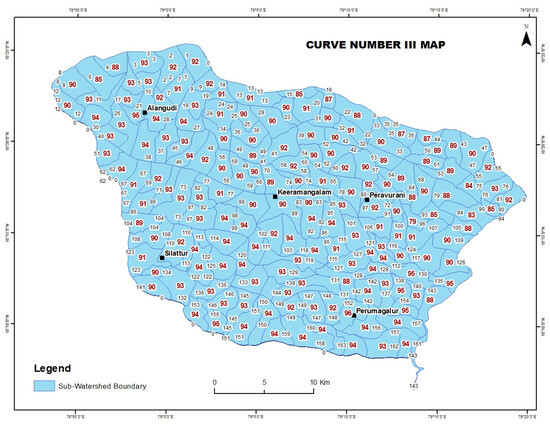
Figure 7.
Demonstrates the assignment of Curve Number II to each micro-watershed.
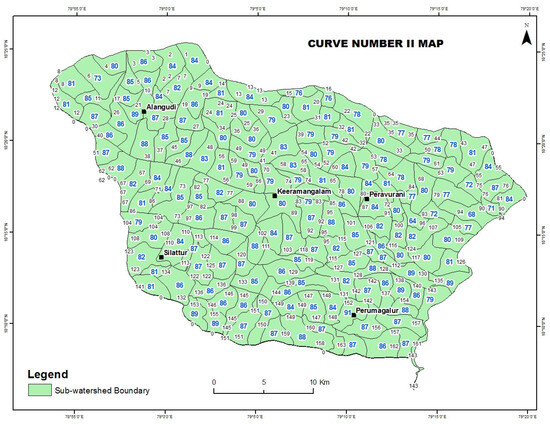
Figure 8.
Shows the assignment of Curve Number III to each micro-watershed.
3.5. Calculation of Run-Off Volume
In this study area, the run-off depth data indicated consistent fluctuations in water levels influenced by seasonal variations and precipitation patterns. The analysis revealed a gradual increase in run-off depth in recent years, highlighting potential shifts in hydrological dynamics. These findings underscore the importance of ongoing monitoring and adaptive water management strategies within the Ambuliyar River basin. The amount of run-off varies seasonally owing to differences in precipitation amounts. Estimating run-off for all seasons enables us to understand the seasonal patterns of water availability in micro-watersheds [40]. Table S3 in the Supplementary Material displays each micro-watershed’s season-wise run-off volumes and tank capacities. The manuscript only displays representative data owing to the table’s size limitations; however, the complete table is available as supplementary material for further clarification. The data on the actual storage capacity of tanks were obtained from unpublished sources. The run-off volume was substantially higher during the northeast (NE) monsoon than in other seasons. Subsequently, the run-off volume and storage capacity of the tanks are correlated. For instance, watershed 110 encompasses two water bodies (102 and 103). The watershed receives a run-off volume of 4.49 million cubic metres (mcm) during the NE monsoon. In contrast, the run-off volume was lower during the summer (0.459 mcm). The cumulative actual capacity of the two tanks in this watershed was measured as 0.315 mcm, which means that the proposed capacity was to be achieved after desilting.
This correlation demonstrates that the water obtained during summer can be efficiently retained within the watershed. Overall, the comparison between the calculated run-off volumes and tank capacities revealed that the run-off volumes consistently exceeded the tank capacities in most micro-watersheds. However, tanks have lost their capacity to store water because of siltation. Hence, the run-off water is discharged from the watershed without being utilised efficiently. If properly desilted, the tanks store water throughout the year. Thus, this study underscores the region’s need for improved water-storage infrastructure and management practices. Furthermore, the major goal of the study is justified in that even during the summer, the tanks can efficiently hold the maximum amount of rainfall run-off water. Thus, sustainable water management, agricultural productivity, and rural development are promoted. Furthermore, research demonstrates that substantial financial investments in desiltation yield favourable results over time.
4. Discussion
Measuring benefits from any restoration program is complex, especially when socioeconomic and environmental benefits are involved. In the case of tank rehabilitation, a cost-benefit analysis can be performed and evaluated in terms of economic and ecological returns. Kumar et al. examined the financial feasibility of tank rehabilitation in Andhra Pradesh, which is prone to drought [6,41,42]. Their findings revealed that the restoration has increased rice crop yield (0.54–0.62 tonnes/ha) and income (from 6045/ha to 8278/ha). Amarnath and Raja [43] examined the economic benefits of tank rehabilitation in the Madurai District of Tamil Nadu. They found that rehabilitation resulted in higher annual incomes, with a benefit-cost ratio exceeding 1.5. Anuradha et al. [44] found that rehabilitating the Pelasur tank in Thiruvannamalai district, Tamil Nadu, significantly improved water productivity. Deivalatha et al. (2014) [45] found that desilting tank beds and supply channels in Ponpadi, Tamil Nadu, increased crop productivity from 4800 to 5400 in the first season and 4425 to 5400 in the second. Better farm income performance was shown by the increase in the benefit-cost ratio, which went from 0.64 to 1.04 in the first season and from 1.13 to 1.31 in the second season.
So far, limited studies have been conducted on the cost-benefit analysis of tank rehabilitation. Typically, studies have assessed economic or ecological benefits [12]. Economic assessments use metrics such as the increase in the area under irrigation, cropping intensity, and crop production, whereas ecological assessments use groundwater improvement. However, these estimations are often conducted in the post-desiltation phase several years after rehabilitation. In this study, we developed a novel method for assessing the efficacy of tank restoration before desiltation.
The present analysis of the correlation between run-off and the storage capacity of tanks within the micro-watershed shows that the run-off volume closely aligns with tank capacity in almost all seasons. The findings suggest tank restoration can effectively store run-off and significantly fulfil agricultural and other essential needs throughout the year, thereby improving the local rural economy. In addition to increasing surface water resources, it also enhances the quality and quantity of groundwater resources in the region. Furthermore, the consistent exceedance of tank capacities by run-off volumes underscores the urgency of implementing adaptive water management strategies to optimise water utilisation and minimise waste.
5. Conclusions
This study quantifies surface run-off using geomatics and the SCS-CN technique. GIS methodologies are beneficial for spatially intersecting different land use and land cover types with various hydrological soil types within watershed basins. Estimating run-off for all seasons and comparing it with the storage capacity of tanks allows us to determine the amount of water that can be captured and stored within each watershed. Such assessments are crucial to determine the cost-effectiveness of tank rehabilitation initiatives. The findings revealed that the run-off water available throughout the year can be effectively stored in the existing tank system, ensuring its availability for diverse purposes, including agriculture, industry, and domestic consumption. This improves the local rural economy and justifies the investment in desiltation. The results revealed that the cost-benefit analysis of a tank rehabilitation project can be performed indirectly, even before the devastation phase. This study introduces a new framework for assessing the economic variability of pre-desiltation measures in watersheds by correlating tank run-off and storage capacity at the micro-watershed level.
Evaluating the estimated run-off volumes against the post-desilt storage capacity of tanks helps determine whether the existing storage infrastructure is adequate to capture and retain run-off. If the run-off volume exceeds the storage capacity, it indicates a potential risk of water loss due to overflow or inadequate storage during the peak run-off periods. Discrepancies between run-off volumes and storage capacities highlight areas where additional storage infrastructure may be required to harness surplus run-off effectively. This information guides decision makers in implementing measures such as rainwater harvesting, groundwater recharge, and controlled release of stored water to maximise available water resources while minimising waste and environmental impact. To enhance the accuracy of our results, we propose increasing the number of rainfall stations to assess rainfall variability at the regional level. Additionally, employing high-resolution terrain data (DEM) and utilising multispectral satellite images for LULC classification can further improve the precision of our analysis and future research. As climate change is expected to alter precipitation patterns and intensify extreme weather events, assessing the resilience of run-off and storage capacity to these changes is vital for building adaptive capacity and ensuring water security under uncertain climate conditions.
Supplementary Materials
The following are available online at https://www.mdpi.com/article/10.3390/geohazards5020023/s1, Table S1: shows the various LULC classes; Table S2: Spatial distribution of HSG categories in each watershed; Table S3: Shows the correlation between the run-off volume in each season’s annual run-off volume and the storage capacity of tanks in each sub-watershed.
Author Contributions
Formal analysis, S.R.; methodology, N.N.P. and S.R.; software, N.N.P.; supervision, S.R.; validation, N.N.P.; writing—original draft, N.N.P.; writing—review and editing, S.M., S.K.D.R. and S.R. All authors have read and agreed to the published version of the manuscript.
Funding
This research was funded by NRDMS, DST, grant number NRDMS/11/3049/014.
Data Availability Statement
The raw data supporting the conclusions of this article will be made available by the authors on request.
Acknowledgments
The authors thank the reviewers for their critical comments and observations that helped us refine the manuscript.
Conflicts of Interest
The authors declare no conflict of interest.
References
- Ramarao, M.V.S.; Sanjay, J.; Krishnan, R.; Mujumdar, M.; Bazaz, A.; Revi, A. On Observed Aridity Changes over the Semiarid Regions of India in a Warming Climate. Theor. Appl. Climatol. 2019, 136, 693–702. [Google Scholar] [CrossRef]
- Chowdhury, K.; Behera, B. Is Declining Groundwater Levels Linked with the Discontinuity of Traditional Water Harvesting Systems (tank Irrigation)? Empirical Evidence from West Bengal, India. Groundw. Sustain. Dev. 2018, 7, 185–194. [Google Scholar] [CrossRef]
- Goyal, M.R.; Panigrahi, P. Sustainable Micro Irrigation Design Systems for Agricultural Crops: Methods and Practices; CRC Press: Boca Raton, FL, USA, 2015; ISBN 9781771882750. [Google Scholar]
- Sakthivadivel, R.; Thiruvengadachari, S.; Bastiaanssen, U.; Molden, D. Performance Evaluation of the Bhakra Irrigation System, India, Using Remote Sensing and GIS Techniques; IWMI: Colombo, Sri Lanka, 1999; ISBN 9789290903758. [Google Scholar]
- Angelakιs, A.N.; Zaccaria, D.; Krasilnikoff, J.; Salgot, M.; Bazza, M.; Roccaro, P.; Jimenez, B.; Kumar, A.; Yinghua, W.; Baba, A.; et al. Irrigation of World Agricultural Lands: Evolution through the Millennia. Water 2020, 12, 1285. [Google Scholar] [CrossRef]
- Pant, N.; Verma, R.K. Tanks in Eastern India: A Study in Exploration; IWMI: Colombo, Sri Lanka, 2010; ISBN 9789290907312. [Google Scholar]
- Barah, B.C. Traditional Water Harvesting Systems: An Ecological Economic Appraisal; New Age International: New York, NY, USA, 1996. [Google Scholar]
- Asian Development Bank. Irrigation Management Transfer: Strategies and Best Practices; Sage Publications: Thousand Oaks, CA, USA, 2008. [Google Scholar]
- Vaidyanathan, A. Water Management and Agriculture in the Palar and the Parambikulam Aliyar Systems in Tamil Nadu; Madras Institute of Development Studies: Tamil Nadu, India, 2004. [Google Scholar]
- Neelakantan, T.R.; Suribabu, C.R.; Selvakumar, R. Opportunity to Restore Irrigation Tanks in the Cauvery Delta by Mining and Deepening. Environ. Dev. Sustain. 2017, 19, 1463–1472. [Google Scholar] [CrossRef]
- Palanisami, K.; Meinzen-Dick, R.; Giordano, M. Climate Change and Water Supplies: Options for Sustaining Tank Irrigation Potential in India; Economic & Political Weekly: Mumbai, India, 2010. [Google Scholar]
- Singh, R.; Akuraju, V.; Anantha, K.H.; Garg, K.K.; Barron, J.; Whitbread, A.M.; Dev, I.; Dixit, S. Traditional Rainwater Management (Haveli cultivation) for Building System Level Resilience in a Fragile Ecosystem of Bundelkhand Region, Central India. Front. Sustain. Food Syst. 2022, 6, 826722. [Google Scholar] [CrossRef]
- De Silva, D.A.; Anderson, E.A.; Kim, J.; Ting Lee, M.-L.; Thoma, M.E. The Association Between Prenatal Food Insecurity and Breastfeeding Initiation and Exclusive Breastfeeding Duration: A Longitudinal Study Using Oregon PRAMS and PRAMS-2, 2008–2015. Breastfeed. Med. 2024, 19, 368–377. [Google Scholar] [CrossRef]
- Gajbhiye, S.; Mishra, S.K.; Pandey, A. Simplified Sediment Yield Index Model Incorporating Parameter Curve Number. Arab. J. Geosci. 2015, 8, 1993–2004. [Google Scholar] [CrossRef]
- Meshram, S.G.; Sharma, S.K. Prioritization of Watershed through Morphometric Parameters: A PCA-Based Approach. Appl. Water Sci. 2017, 7, 1505–1519. [Google Scholar] [CrossRef]
- Santra, A.; Mitra, S.S. Remote Sensing Techniques and GIS Applications in Earth and Environmental Studies; IGI Global: Hershey, PA, USA, 2016; ISBN 9781522518150. [Google Scholar]
- International Association of Hydrological Sciences. Scientific Assembly Remote Sensing and Geographic Information Systems for Design and Operation of Water Resources Systems; International Association of Hydrological Sciences: Wallingford, UK, 1997; ISBN 9781901502152. [Google Scholar]
- Pachpute, J.S.; Tumbo, S.D.; Sally, H.; Mul, M.L. Sustainability of Rainwater Harvesting Systems in Rural Catchment of Sub-Saharan Africa. Water Resour. Manag. 2009, 23, 2815–2839. [Google Scholar] [CrossRef]
- Khaleghi, M.R. The Influence of Deforestation and Anthropogenic Activities on Run-off Generation. J. Forensic Sci. 2017, 63, 245–253. [Google Scholar]
- Tripathi, A.; Attri, L.; Tiwari, R.K. Spaceborne C-Band SAR Remote Sensing-Based Flood Mapping and Run-off Estimation for 2019 Flood Scenario in Rupnagar, Punjab, India. Environ. Monit. Assess. 2021, 193, 110. [Google Scholar] [CrossRef] [PubMed]
- Mishra, S.K.; Singh, V.P. Soil Conservation Service Curve Number (SCS-CN) Methodology; Springer Science & Business Media: Berlin/Heidelberg, Germany, 2013; ISBN 9789401701471. [Google Scholar]
- Nasir, N.; Selvakumar, R. Influence of Land Use Changes on Spatial Erosion Pattern, a Time Series Analysis Using RUSLE and GIS: The Cases of Ambuliyar Sub-Basin, India. Acta Geophys. 2018, 66, 1121–1130. [Google Scholar] [CrossRef]
- Nasir, N.; Selvakumar, R. Estimating the Loss of Water Spread Area in Tanks Using Remote Sensing and GIS Techniques in Ambuliyar Sub-Basin, Tamilnadu. In Lecture Notes in Civil Engineering; Springer Science & Business Media: Berlin/Heidelberg, Germany, 2021. [Google Scholar]
- Satheeshkumar, S.; Venkateswaran, S.; Kannan, R. Rainfall–run-off Estimation Using SCS–CN and GIS Approach in the Pappiredipatti Watershed of the Vaniyar Sub Basin, South India. Model. Earth Syst. Environ. 2017, 3, 1–8. [Google Scholar] [CrossRef]
- El-Bagoury, H.; Gad, A. Integrated Hydrological Modeling for Watershed Analysis, Flood Prediction, and Mitigation Using Meteorological and Morphometric Data, SCS-CN, HEC-HMS/RAS, and QGIS. Water 2024, 16, 356. [Google Scholar] [CrossRef]
- ASCE/EWRI Curve Number Hydrology Task Committee; Hawkins, R.H. Curve Number Hydrology: State of the Practice; Amer Society of Civil Engineers: Reston, VA, USA, 2009; ISBN 9780784410042. [Google Scholar]
- Beven, K.J. Rainfall-Runoff Modelling: The Primer; John Wiley & Sons: Hoboken, NJ, USA, 2012; ISBN 9780470714591. [Google Scholar]
- Abraham, S.; Huynh, C.; Vu, H. Classification of Soils into Hydrologic Groups Using Machine Learning. Brown Univ. Dig. Addict. Theory Appl. 2019, 5, 2. [Google Scholar] [CrossRef]
- Rani, S. Climate, Land-Use Change and Hydrology of the Beas River Basin, Western Himalayas; Springer Nature: Berlin/Heidelberg, Germany, 2023; ISBN 9783031295256. [Google Scholar]
- Di Gregorio, A.; Food and Agriculture Organization of the United Nations. Land Cover Classification System: Classification Concepts and User Manual: LCCS; Food & Agriculture Org.: Rome, Italy, 2005; ISBN 9789251053270. [Google Scholar]
- National Research Council; Division on Earth and Life Studies; Board on Earth Sciences and Resources; Geographical Sciences Committee; Committee on Needs and Research Requirements for Land Change Modeling. Advancing Land Change Modeling: Opportunities and Research Requirements; National Academies Press: Washington, DC, USA, 2014; ISBN 9780309288361. [Google Scholar]
- Moon, G.W.; Ajmal, M.; Ahn, J.H.; Kim, T.W. Investigating practical alternatives to the NRCS-CN method for direct run-off estimation using slope-adjusted curve numbers. KSCE J. Civ. Eng. 2016, 20, 3022–3030. [Google Scholar] [CrossRef]
- Matomela, N.; Tianxin, L.; Morahanye, L.; Bishoge, O.K.; Ikhumhen, H.O. Rainfall-runoff estimation of Bojiang lake watershed using SCS-CN model coupled with GIS for watershed management. J. Appl. Adv. Res. 2019, 4, 16–24. [Google Scholar] [CrossRef]
- Nasiri, V.; Deljouei, A.; Moradi, F.; Sadeghi, S.M.M.; Borz, S.A. Land Use and Land Cover Mapping Using Sentinel-2, Landsat-8 Satellite Images, and Google Earth Engine: A Comparison of Two Composition Methods. Remote Sens. 2022, 14, 1977. [Google Scholar] [CrossRef]
- Saralioglu, E.; Vatandaslar, C. Land Use/land Cover Classification with Landsat-8 and Landsat-9 Satellite Images: A Comparative Analysis between Forest- and Agriculture-Dominated Landscapes Using Different Machine Learning Methods. Acta Geod. Geophys. 2022, 57, 695–716. [Google Scholar] [CrossRef]
- Kumar, A.; Kanga, S.; Taloor, A.K.; Singh, S.K.; Đurin, B. Surface Run-off Estimation of Sind River Basin Using Integrated SCS-CN and GIS Techniques. HydroResearch 2021, 4, 61–74. [Google Scholar] [CrossRef]
- Available online: https://www.plantarchives.org/SPL%20ISSUE%2020-2/178__1156-1160_.pdf (accessed on 27 March 2024).
- Masruroh, H.; Soemarno, S.; Kurniawan, S.; Leksono, A.S. A Spatial Model of Landslides with A Micro-Topography and Vegetation Approach for Sustainable Land Management in the Volcanic Area. Sustain. Sci. Pract. Policy 2023, 15, 3043. [Google Scholar] [CrossRef]
- Rizeei, H.M.; Pradhan, B.; Saharkhiz, M.A. Surface Run-off Prediction Regarding LULC and Climate Dynamics Using Coupled LTM, Optimised ARIMA, and GIS-Based SCS-CN Models in Tropical Region. Arab. J. Geosci. 2018, 11, 1–16. [Google Scholar] [CrossRef]
- Guzha, A.C.; Nobrega, R.L.B.; Kovacs, K.; Rebola-Lichtenberg, J.; Amorim, R.S.S.; Gerold, G. Characterizing Rainfall-Run-off Signatures from Micro-Catchments with Contrasting Land Cover Characteristics in Southern Amazonia. Hydrol. Process. 2015, 29, 508–521. [Google Scholar] [CrossRef]
- Puttaswamy, N.K.; Kulkarni, G.N. Rehabilitation of Tank Systems and Its Impact on Farm Economy: An Empirical Analysis in Haveri District of Karnataka, India; LAP Lambert Academic Publishing: Saarbrucken, Germany, 2015; ISBN 9783659764103. [Google Scholar]
- Karthikeyan, C.; Suresh Kumar, D.; Palanisamy, K. Sustainable Management of Tank System in South India; LAP Lambert Academic Publishing: Saarbrucken, Germany, 2012; ISBN 9783659208997. [Google Scholar]
- Amarnath, J.S.; Karthik Raja, P. Examined the economic benefits of tank rehabilitation in Madurai District, Tamil Nadu. Agric. Econ. Res. Rev. 2006, 19(1), 187–194. [Google Scholar]
- Anuradha, B.; Packialakshmi, S.; Sanjay, N.; Vivekananthan, V. An Analytical Study for Assessing Water Productivity in Pre- and Post-Rehabilitation Period of Rural Tank System. Adv. Civ. Eng. 2022, 2022, 1119931. [Google Scholar] [CrossRef]
- Deivalatha, A.; Senthilkumaran, P.; Ambujam, N.K. Impact of desilting of irrigation tanks on productivity of crop yield and profitability of farm income. Acad. J. 2014, 9, 1833–1840. [Google Scholar] [CrossRef]
Disclaimer/Publisher’s Note: The statements, opinions and data contained in all publications are solely those of the individual author(s) and contributor(s) and not of MDPI and/or the editor(s). MDPI and/or the editor(s) disclaim responsibility for any injury to people or property resulting from any ideas, methods, instructions or products referred to in the content. |
© 2024 by the authors. Licensee MDPI, Basel, Switzerland. This article is an open access article distributed under the terms and conditions of the Creative Commons Attribution (CC BY) license (https://creativecommons.org/licenses/by/4.0/).